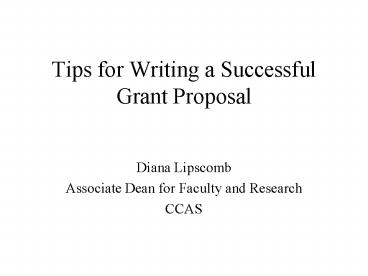Tips for Writing a Successful Grant Proposal PowerPoint PPT Presentation
1 / 20
Title: Tips for Writing a Successful Grant Proposal
1
Tips for Writing a Successful Grant Proposal
- Diana Lipscomb
- Associate Dean for Faculty and Research
- CCAS
2
Life Cycle of a Proposal
Proposal submitted by ORS to Sponsor
90 days
3
Life Cycle of a Proposal
Proposal arrives and is checked for
appropriateness and compliance
Not OK
Proposal returned unfunded
30 days
4
Life Cycle of a Proposal
Proposal arrives and is checked for
appropriateness and compliance
OK
30 days
5
Life Cycle of a Proposal
Reviews received
Outside Panel meets and recommends proposals
for funding
4 Months
6
NSF Merit Review Criteria
- Intellectual Merit
- Advancing knowledge and understanding
- Proposer qualifications (and results of prior
work) - Creative and original concepts?
- Conception and organization
- Resources
- Broader Impacts
- Promoting teaching, training and learning?
- Broaden the participation of underrepresented
groups - Enhance the infrastructure for research and
education (facilities, instrumentation, networks
and partnerships) - Broad dissemination
- Benefits to society
Typical NSF Panel Review Meeting
7
Life Cycle of a Proposal
Not Recommended for Funding
- Proposal returned with
- reviews
- summary of panel discussion
30 days (total time 6 months)
8
Life Cycle of a Proposal
Recommended for Funding
Program officer determines which of the
recommended proposals can be funded
60 days (total time 7 months)
9
Life Cycle of a Proposal
Recommended for Funding
Program officer determines which of the
recommended proposals can be funded
Congratulations!
90 days (total time 8 months)
10
Proposals to Federal SponsorsVS.Non-Federal
Sponsors
11
Federal Sponsors
- Federal agencies detailed requirements and forms.
- Proposals to federal agencies are submitted by
ORS. - Proposals to federal agencies generally will go
out for peer review. - Some federal agencies have a mission and your
research must closely match their interests (U.S.
Department of Energy, NASA), while others are
not, and you may submit a research project of
your own creation (National Science Foundation,
National Endowment for the Humanities). The U.S.
Department of Education is a little of bothyou
can submit your project idea within one of their
different areas of interest. - Federal agencies send reviews if a proposal is
rejected. If for some reason you don't receive
them, ask for them.
12
Non-Federal Sponsors
- Most proposals to foundations or corporations are
called "letter proposals", only several pages
long, and will need to stress what you propose to
do, why it is important, and how you will do it. - They generally do not send your proposal for a
peer review but instead have a review panel. - Read their guidelines carefully to determine
their areas of interest. If you and they "fit",
submit your letter proposal if they do not list
specific proposal requirements. - If you are rejected you may never know why.
Reviews are often not sent.
13
Read the Request for Proposals! (RFP)
- Do NOT deviate from the guidelines
- Address all the points raised in the RFP
14
Parts of a Proposal
- Cover or Title Page
- Table of Contents
- Abstract
- The abstract should not be an abstract of the
proposal, rather a self-contained description of
the research that would result if the proposal is
funded.
15
The Narrative
- Write with the reviewers and panel constituency
in mind - Write for both experts and generalists
- Need to show mastery of relevant content/areas
- Need to avoid overloading readers with jargon and
technicalities
16
What Reviewers Look For
- Proposals that are organized. Make their job
easier by exactly following the guidelines. - Proposals that they can understand. Avoid jargon.
Keep your language as clear and concise as
possible. Don't leave reviewers guessing, and
leave nothing to the imagination. - Proposals that are pleasing to the eye. Think
what you can do to counter a reviewer's "fatigue
factor." They will frequently be reviewing from
20 to 50 proposals at one time. Small type and
long paragraphs are seldom a good idea. Use
plenty of white space, as well as bulleted items
to catch attention - Proposals that someone else had read. Leave
enough time to have your advisor and friends read
and critique what you have written.
17
What Reviewers Look For (cont)
- Proposals that answer the questions
- What is this person doing? (Many reviewers have
complained that they were pages and pages into
the proposal before they could winnow out the
project.) - Why is it important?
- Is it innovative? (Innovation is an essential
ingredient in proposals today.) - How is this person going to do it?
- Has this person made the case?
18
Basic Steps in Writing a Budget
(ORS will help you with this! Go to them early
in the process)
- Decide which budget line items are required by
the project. - Price the items. Prorate costs to accommodate
anticipated increases if a multi-year budget is
included. - Review budget to ensure that it is complete and
justified. - Typical budget items
- Salaries
- Fringe benefits
- Travel
- Supplies
- Publication Costs
- Other direct costs (ex. photocopying, equipment)
- Indirect costs or overhead
19
Budget Justification
- Arrange by budget categories and briefly explain
how budget items were estimated. - Details of salary and benefit rates, travel
rates, equipment needs, supplies, and indirect
costs are among the items usually included.
20
Do not give up!
- According to NSF, one out of every four
competitive grants you write will be funded - Decision not to fund, does not necessarily
reflect on the quality of your grant proposal - Good people (even excellent people) can have
proposals rejected, take rejection as a learning
experience

